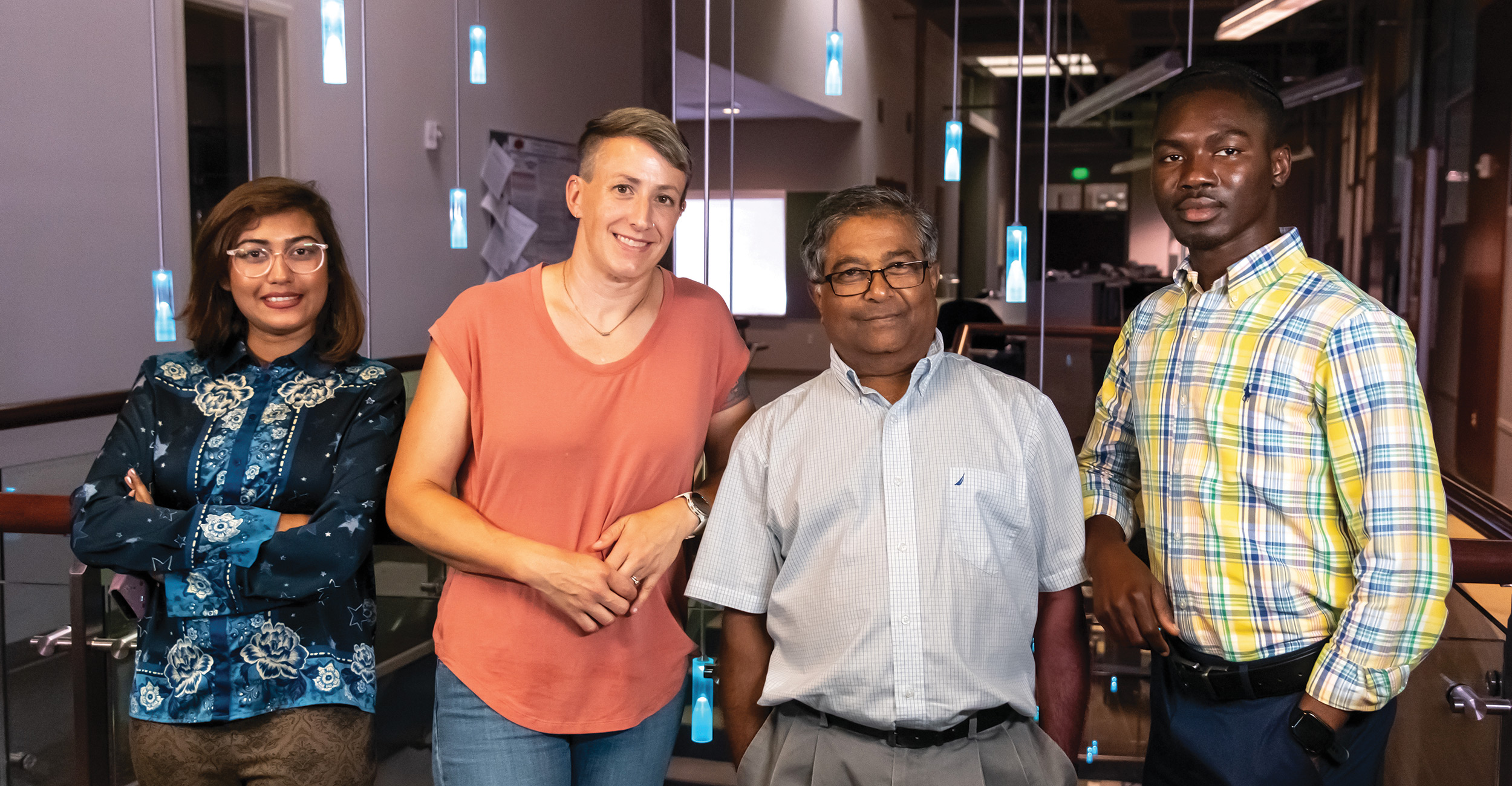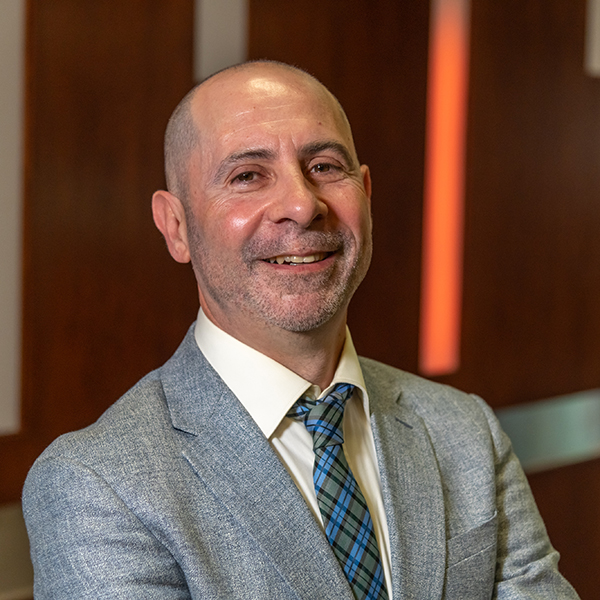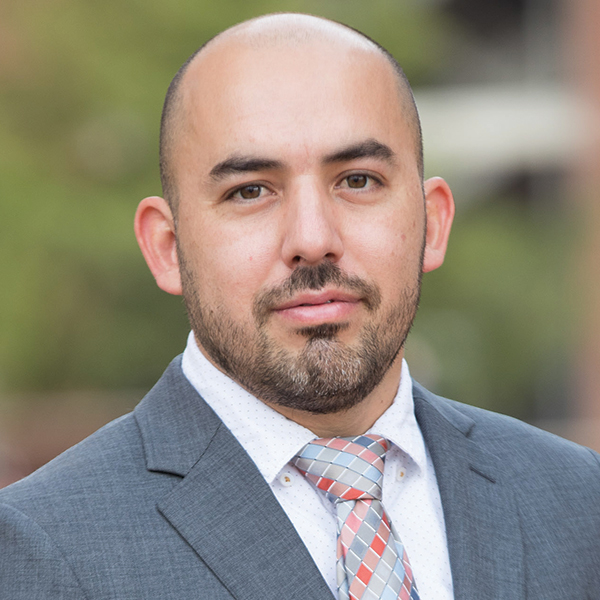
Symbiotic Relationships: CAS leading the way in transdisciplinary life sciences research
Friday, August 22, 2025
Media Contact: Elizabeth Gosney | CAS Marketing and Communications Manager | 405-744-7497 | egosney@okstate.edu
As the hub of life sciences at Oklahoma State University, the College of Arts and Sciences is committed to research that bridges disciplines and creates breakthroughs for the betterment of societies around the world.
With hundreds of faculty, staff and students across the departments of biology, psychology, and microbiology and molecular genetics, there’s no easy way to fully capture the extent of transdisciplinary life science research within CAS. However, highlighted here are three of the many projects bringing distinction to the college and the university.
More than a Gut Feeling
A recent collaboration between microbiology and molecular genetics professor Dr. Babu Fathepure and biology associate professor Dr. Liz McCullagh aims to characterize gut bacteria in Fragile X Syndrome — the most common single-gene cause of Autism Spectrum Disorder — to better understand how gut microbiome dysbiosis may be linked to changes in the brain.
“Our goal is to identify specific microbial metabolites that may be indicative of, or contribute to, the underlying causes of the condition,” Fathepure said. “These findings will be further studied by understanding what specific roles the dysregulated bacteria play in gut-brain interactions, and how those changes may be related to FXS and ASD.”
Fathepure and McCullagh explained that interest in the gut-brain axis — or bidirectional communication between the gastrointestinal tract and the central nervous system — has increased in recent years, particularly in relation to neurodevelopmental and neuropsychiatric disorders.
A key component of the gut-brain axis is the community of microorganisms residing in the GI tract — known as the gut microbiome.
“Although research is still emerging, studies using FXS mouse models have revealed alterations in both the abundance and composition of gut microorganisms in Fragile X Syndrome,” McCullagh said. “Understanding which bacteria may be most important in this link, and what microbial metabolites may be involved, is key to understanding the role microbes play in treating ASD.”
McCullagh’s lab uses FXS mouse models, meaning that the same FXS gene that is impacted in humans has been disrupted in the mice. This allows for a more mechanistic study of the condition in a species with similar genes to humans.
By integrating their respective departments’ expertise in molecular genetics, neurobiology, microbial physiology and ecology, and systems biology, Fathepure and McCullagh can better identify microbial and metabolic signatures associated with FXS-related symptoms, which could lead to innovative, personalized treatments.
Furthermore, with support from the National Institutes of Health-funded Oklahoma Center for Microbiome Research, McCullagh, Fathepure and OSU graduate student Sabiha Alam have already collected preliminary data suggesting that there are indeed differences in the gut microbial species and abundance in mice with FXS compared to animals that are unaffected, or neurotypical.
“This research holds significant potential for broad societal impact, especially in advancing precision medicine for neurodevelopmental disorders,” Fathepure said. “By uncovering the role of the gut-brain axis in FXS, this work paves the way for novel, low-risk therapeutic strategies — such as probiotics, dietary interventions, or microbiome-based diagnostics — that could improve quality of life for individuals with FXS and related conditions like ASD.”
For students, engaging in this interdisciplinary research offers hands-on experience at the intersection of microbiology, neuroscience and genomics, preparing them for careers in translational science and biomedical innovation.
“In alignment with the land-grant mission, our research exemplifies public service by addressing real-world health challenges, promoting community well-being and fostering accessible, science-driven solutions that benefit people in Oklahoma, particularly those in underserved or rural areas,” McCullagh said.
Unearthing Microplastic Mysteries

With 23 departments across the arts and humanities, social sciences, math and natural sciences, CAS faculty understand the value of varied perspectives and expertise.
So, when biology’s Dr. Matteo Minghetti was invited to speak at a College of Engineering, Architecture and Technology lecture series by Dr. Jorge Gonzalez Estrella, he gladly accepted.
The two faculty members have since joined forces to research microplastics. The result? A multidisciplinary proposal that uses quantifiable approaches and innovative tools to better understand the role of environmental weathering and gastrointestinal digestion on the bioavailability and toxicity of microplastic and cadmium mixtures.
“Microplastics represent an emerging human health hazard as either a direct environmental contaminant or as a component of other mixed pollutants,” said Gonzalez Estrella, associate professor of civil and environmental engineering and PI on the project.
“Once introduced into the environment, microplastics are exposed to degrading conditions, such as ultraviolet radiation, that change their chemical and morphological composition.”
Microplastic UV-degradation is poorly understood in the context of environmental pollutants, Minghetti said. While they know that humans are mainly exposed to microplastics through contaminated food and water, “the fate of MPs during digestion is largely unknown.”

“The key barrier to advancing our understanding of the health risk of MPs is a lack of information linking MPs’ environmental chemical transformations with bioaccumulation of MPs, and specific health impacts,” Minghetti said. “Investigating the environmental impact of microplastics is critical to elucidating their role as pervasive and persistent contaminants that disrupt ecosystem function, bioaccumulate in aquatic organisms, and pose emerging risks to environmental and human health.”
As Minghetti and Gonzalez Estrella test their hypotheses, undergraduate students are actively involved in the process. In fact, students are why the project received R15 funding — or a Research Enhancement Award — from the National Institutes of Health.
“This project directly supports the NIH-R15 mission by engaging undergraduate students in hands-on research, equipping them with critical skills in environmental toxicology and preparing them to become the next generation of scientists,” Minghetti said. “Through their work, students will contribute to a deeper understanding of microplastics’ environmental impact, particularly their bioavailability and physiological effects in aquatic organisms.
“The societal benefit of this research lies in generating data that can inform science-based policies aimed at mitigating microplastic emissions and protecting both environmental and human health.”
Medicine of the Mind
On Riverside Drive in the heart of Tulsa, OSU’s Hardesty Center for Clinical Research and Neuroscience is bringing together experts in medicine and life sciences and providing them with the space and equipment to mitigate the impacts of addictive behavior disorders.
One of the experts housed in Tulsa is CAS’s own Dr. Amanda Morris, a professor in the Department of Psychology, who describes the Hardesty Center as a “hidden gem for OSU.”

“We have definitely delivered on the promise that the Hardesty Center would be built upon interdisciplinary approaches and collaboration,” said Morris, referencing a 2021 statement by Dr. Julie Croff, founding executive director of the National Center for Wellness and Recovery in Tulsa. NCWR, like the Hardesty Center, is part of the OSU System.
“OSU Psychology has a strong presence on the OSU-Tulsa campus, with over 75 undergraduate students,” Morris said, adding that they’re able to fund numerous doctoral students from CAS as well as other disciplines like public health. “We support research projects that benefit students and faculty across campus, and we look forward to growing our impact on both graduate and undergraduate student learning at OSU.”
Morris is involved in several NIH- funded projects in Tulsa, including the Center for Integrative Research on Childhood Adversity, which was established in 2016 as the first national interdisciplinary research center designed to integrate biological and behavioral approaches to the study of adversity and resilience. She is also a co-leader of the Healthy Brain Child Development study, which involves university recruitment sites in 27 locations around the U.S.
“We collect data from pregnant mothers and their newborns from across the country in hopes of better understanding brain development and the potential effects of exposure to substances and other environmental, social and biological factors,” Morris said. “We have been following the children for 10 years, collecting brain data through MRI and EEG at our Tulsa center.”
Through her extensive involvement in a range of research projects, Morris has a strong appreciation for the power of transdisciplinary research across the life sciences and beyond.
“Cutting-edge neuroscience research is being conducted in Tulsa by a number of CAS faculty and students,” Morris said. “This research is bringing national recognition to OSU and is helping us better understand factors that influence brain development and health.”
New Life: Creating OSU's New Department of Biology
Oklahoma State University is advancing education and research in biological sciences with the upcoming merger of the Department of Integrative Biology and the Department of Plant Biology, Ecology, and Evolution. On July 1, the two units officially became a single entity: the OSU Department of Biology.
“This merger reflects our dedication to evolving with the needs of our students and the scientific community,” said Dr. Melinda Cro, dean of the College of Arts and Sciences. “By bringing together these two strong departments, we are enhancing our ability to train future scientists and health care professionals, solve pressing biological challenges and elevate OSU’s impact in the life sciences.”
The unification bolsters OSU’s commitment to interdisciplinary collaboration, providing students with a more comprehensive and streamlined academic experience.
“We have always shared much of our curriculum and this opportunity further allows our faculty to work closely together to improve course sequencing and content to prepare our students for their future careers,” said Dr. Jason Belden, Department of Integrative Biology head. “Our merged department will help foster continued research collaboration, especially in areas of joint interest like environmental protection, genetics and evolution.”
While the department's name has changed, the existing major options are staying the same. These include bachelor’s degrees in biology, physiology, plant biology and zoology, and graduate degrees in integrative biology and plant biology.
Read the full Department of Biology announcement from May 2025 here.
Story By: Elizabeth Gosney | Photos By: Jason Wallace | casnews@okstate.edu
